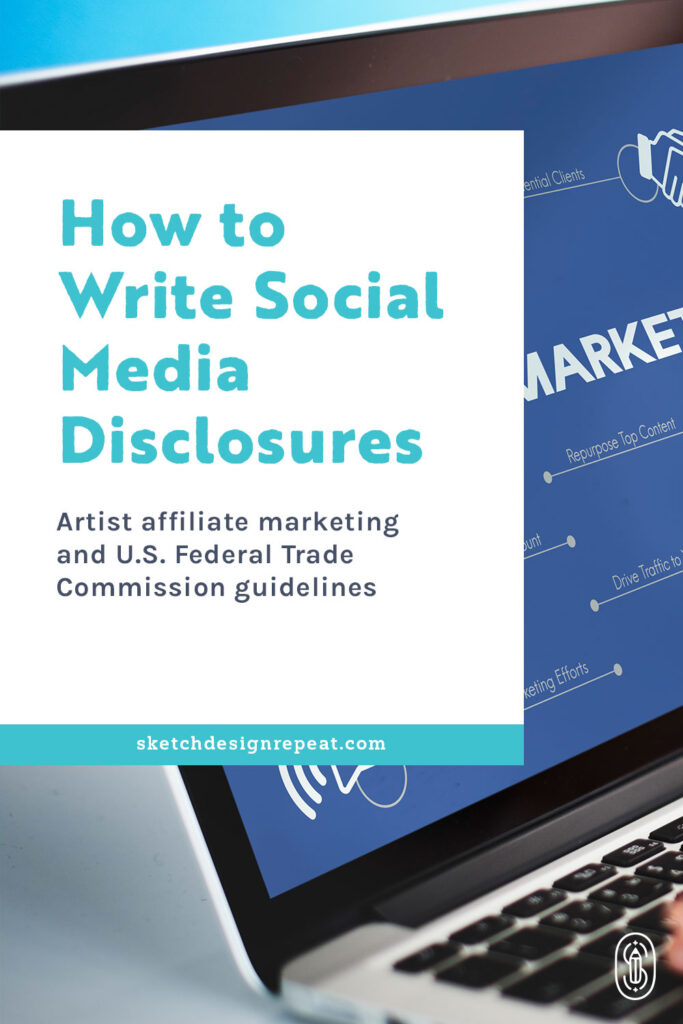Affiliate marketing plays a major role in today’s online economy. According to SaaS Scout Research Group, affiliate marketing accounts for 15% of all digital media advertising revenue and 15% to 30% of all online sales. This has caused the U.S. Federal Trade Commission (“FTC”) to take notice.
While the FTC has had rules in place for a long time, it’s ramped up its enforcement efforts in recent years. Thus, it is important for all affiliate marketers – including surface designers and artists – to understand and apply the FTC’s guidelines related to affiliate marketing to avoid fines.

If you receive compensation for promoting another company or its products on your website, blog post, social media post, YouTube video, or any other form of online format, you need an FTC affiliate disclosure. Such disclosures help protect consumers from deceptive advertising practices.
Bloggers, e-commerce merchants, affiliate marketers, influencers, and others using the internet to promote products or brands are required to disclose their financial relationship to the brands and products they recommend or mention.
What is an FTC Affiliate Disclosure?
An FTC affiliate disclosure is a prominent statement that clearly states your relationship to companies that pay you to sponsor or otherwise promote their offerings. Anyone engaged in affiliate marketing needs an FTC affiliate disclosure.
Affiliate marketing is when internet influencers, bloggers, YouTube video creators, or other digital professionals promote a brand or a product that is not owned by them. Promotion is loosely defined as driving traffic to a company’s website with the expectation of receiving a reward when a product is purchased. Examples of affiliate marketing include product reviews, paid guest posts, or recipe videos that link to a cooking product that is used in the recipe.
You may also receive different forms of compensation, including cash payments, in-kind compensation, special access to products, services, or events, free products, store credit, discounts, sponsorships, revenue-sharing agreements, etc.
If you are being compensated in ANY of these ways for mentioning a brand or a product, then you MUST include an FTC affiliate disclosure near the relevant link or review in order to avoid FTC fines.
What are the four standards to be met in all FTC affiliate disclosures?
1. The disclosure should be frequent.
Placing one single disclosure on your home page or link to one in your footer is not enough to comply with the FTC’s guidelines. Disclosures must be on every page of your website or social media post that has a promotion, review, recommendation, comment, or article that promotes a product or service for which you receive any form of compensation.
2. The disclosure should be clear.
The disclosure must make it immediately clear to the reader that you are being compensated for your promotion, review, or recommendation.
You may include other information in your disclosure, such as whether you personally tested the product or that your review is honest, but you MUST disclose the compensation first – at the beginning of the review or recommendation – and clearly. It should not be hidden in legalese.
3. The disclosure must be conspicuous.
The disclosure must be conspicuous and easy to see on your site. It must be clear to a reasonable consumer. It has to stand out from the other text on the page so that it is immediately evident to all visitors.
The disclosure text must be as large or larger than the main text. The disclosure text must be colored (not black or gray) and contrast with its background and the main text. The disclosure must not be lighter than its background or the main text. It must begin with the word “Disclosure.”
4. The disclosure should require no action.
Your disclosure must be visible to anyone who visits your review or endorsement. The visitor should not be required to take any action to view your disclosure. Such actions include: scrolling (your disclosure must appear “above the fold,” meaning that a visitor does not have to scroll down to see it), or clicking (visitors should not have to click on anything to see your disclosure).
While the FTC expects affiliate marketers to comply with the Enforcement Guidelines, it also makes clear that this is not sufficient on its own. Rather than serving as a definitive roadmap, the Endorsement Guidelines are instead just that — guidelines that are intended to help affiliate marketers and companies navigate their compliance obligations.

What are the FTC’s guidelines for best practices?
The FTC’s guidelines for best practices are referred to as the “four Ps” and they focus on four key considerations, as follows.
1. Prominence
Is the disclosure big enough for consumers to read easily? Disclosures must be in a font of at least the same size as your text in the rest of the post. Use big enough fonts that users can easily read. Also consider contrast, too. White text on a light or variegated background is not likely to be noticed. Nor will a fine-print statement that has to compete with a dynamic or distracting image.
2. Presentation
Is the disclosure worded in a way that consumers can easily understand? Using legalese or technical terminology reduces the likelihood that consumers will get the message. Disclosures must be obvious and not buried in a long paragraph or unrelated text or hashtags.
3. Placement
Is the disclosure placed where consumers are likely to look? The disclosures must be next to the content to which it relates; a viewer should not need to scroll to view the disclosure or only be accessible by clicking on a link referring to your Disclaimer, “about me,” or biographical pages. The bottom of the page or screen is not a place that most consumers look.
4. Proximity
Is the disclosure located near the claim it modifies? Make sure that the disclosure is not distant from the prominent headline.
Related Article: Affiliate Marketing as an Artist
What are the FTC disclosure guidelines for social media?
For social media posts, a popular way of disclosing affiliate marketing is by adding hashtags and disclaimers. #Ad, #sponsored, #advertising, #affiliatelink, and #paidpromotion are popular hashtags you can add to your post that will help make it clear to your audience that you are receiving compensation for your promotional efforts. But on their own, they may not be enough to ensure compliance with the FTC.
In general, you should always include some form of disclaimer in your posts, one that makes the affiliate relationship crystal clear. A few examples of a prominent disclaimer, placed in its own text box at the very top of the post, would be:
- Disclosure: I’m using a referral link below. That means that if you sign up/purchase/enroll, I might/will receive a small commission.
- Disclosure: This post includes affiliate links for which I may make a small commission at no extra cost to you should you make a purchase.
Anyone who views these posts will know right away that the poster is engaged in affiliate marketing. There’s no deception or underhandedness — it’s totally obvious that they are being paid a commission for their promotional efforts. To be clear, just adding a hashtag #ad or #affiliate at the end of a social media post is grossly insufficient.

Affiliate link disclosure examples that comply with the FTC Guidelines:
- In a red text box above the fold: “This website is supported by its audience. When you purchase through links on this site, we may earn an affiliate commission. Learn more.” With a link to the site’s Disclaimer.
- “These are items that I use and love. If you take action (i.e., make a purchase) after clicking one of the affiliate links, I’ll earn some coffee money (which I promise to drink) while continuing to support your journey. You will not pay a higher price.”
- “Heads up: This page contains affiliate links. If you click and purchase, I may receive a small commission at no extra cost to you. I only recommend products that I have personally vetted.”
- “This page includes affiliate links. Learn what that means for me and for you.” With a contextual link to their full affiliate disclosure.
- “When you buy something using the links in our post/newsletter/video, we may earn a small commission at no additional cost to you. We do not accept money for reviews. Read more about our affiliate disclosure policy here.” With a contextual link to their full affiliate disclosure.
- “Please note that some links on this page are retail affiliate links. We may receive a small commission at no extra cost to you, if you click through the link and make a purchase from one of our partners.”
- “We review products independently, but we may receive an affiliate commission at no cost to you for purchases made by clicking on one of the referral links on this page.”
To engage in affiliate marketing, you are responsible for having proper affiliate disclosures in place in your content. These disclosures must be clear and conspicuous to a reasonable consumer, as well as easily noticeable. Disclosures should be placed in close proximity to the claims being made and should be prominently displayed to draw the consumer’s attention to them.
To increase the noticeability of disclosures, distracting elements should be avoided. Repetition of disclosures enhances their noticeability. Finally, different media types should be properly utilized to increase the noticeability of disclosures.
If you follow these simple guidelines, you are not likely to get fined by the FTC for affiliate deals and sponsorships. In general, the FTC seeks to make businesses transparent about their practices to consumers. With good intentions and a little care in drafting and placing your affiliate disclosures, you can rest easy that you have complied with the FTC’s affiliate marketing guidelines.

Written by Michael Sheridan, Esquire
Website: www.michaelsheridanesquire.com
Instagram: @michaelsheridandesigns
Michael is a surface pattern designer and commercial litigator with 25 years’ experience. He believes that a strong legal foundation is essential to business success. Michael also is an avid crafter and quilter, specializing in translating ancient Islamic tile patterns into quilt designs.